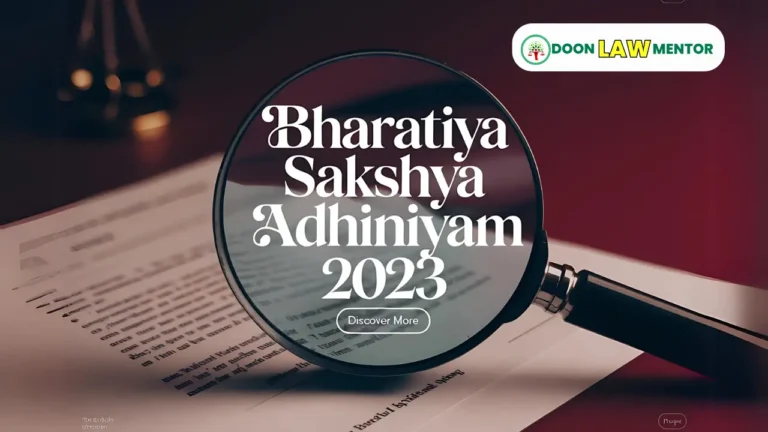Explore unlawful assembly and public tranquility in the Bharatiya Nyaya Sanhita 2023, covering BNS Sections 189–197, landmark cases like Kedar Nath Singh, and recent legal updates. Master this for Judiciary, APO, UPSC, CLAT, and AIBE with Doon Law Mentor’s expert insights!
Table of Contents
Introduction
What happens when a group’s actions threaten societal peace? Unlawful assembly and public tranquility in the Bharatiya Nyaya Sanhita 2023 address this critical issue. These laws target group behaviors that disrupt public order, like riots or violent protests. For lawyers, law students, and aspirants preparing for Judiciary, Law schools, APO, UPSC, CLAT, and AIBE, understanding unlawful assembly and public tranquility in the Bharatiya Nyaya Sanhita 2023 is essential. Replacing the Indian Penal Code (IPC), the BNS modernizes provisions to maintain peace. This ultra-detailed article analyzes BNS Sections 189–197, landmark judgments, enforcement mechanisms, and recent developments. With Doon Law Mentor’s guidance, you’ll master unlawful assembly and public tranquility in the Bharatiya Nyaya Sanhita 2023.
Understanding Unlawful Assembly and Public Tranquility
Definition of Unlawful Assembly
Unlawful assembly and public tranquility in the Bharatiya Nyaya Sanhita 2023 define an unlawful assembly as five or more persons with a common object to commit an illegal act or a lawful act through illegal means. BNS Section 189 outlines this, replacing IPC Section 141. It aims to prevent disruptions to public peace.
Public Tranquility Explained
Public tranquility refers to a state of peace and order in society. Unlawful assembly and public tranquility in the Bharatiya Nyaya Sanhita 2023 target acts like rioting, affray, or promoting enmity that endanger this peace. These offences affect society at large, not just individuals .
Historical Context
The concept of unlawful assembly and public tranquility in the Bharatiya Nyaya Sanhita 2023 stems from English common law, codified in the IPC in 1860. The Statute of Northampton (1328) addressed armed gatherings threatening peace. In India, colonial laws targeted protests against British rule. The BNS modernizes these provisions for contemporary challenges .
Read More: Consent as a Legal Defence in India: IPC vs BNS Analysis
Scope of Offences
Unlawful assembly and public tranquility in the Bharatiya Nyaya Sanhita 2023 cover:
- Unlawful assemblies (Section 189).
- Rioting (Section 191).
- Promoting enmity between groups (Section 196).
- Affray (Section 197).
These provisions, under Chapter XI of the BNS, ensure public safety while balancing rights like freedom of assembly under Article 19 of the Constitution.
Legal Framework: BNS Sections 189–197
BNS Section 189: Unlawful Assembly
Section 189 defines an unlawful assembly as five or more persons with a common object to:
- Overawe the government or public servants by criminal force.
- Resist legal processes.
- Commit mischief, trespass, or other offences.
- Forcibly take property or enforce rights.
- Compel illegal acts.
Punishment includes up to six months’ imprisonment, a fine, or both (Section 189(2)). Refusal to disperse aggravates penalties (Section 189(3)). Unlawful assembly and public tranquility in the Bharatiya Nyaya Sanhita 2023 rely on this section to curb disruptive gatherings (Vakilsearch.com, 2025).
BNS Section 190: Liability of Members
Section 190 holds every member of an unlawful assembly liable for offences committed in pursuit of the common object. Unlawful assembly and public tranquility in the Bharatiya Nyaya Sanhita 2023 ensure collective responsibility, even for passive members (Kanoongpt.in, 2025).
BNS Section 191: Rioting
Section 191 defines rioting as an unlawful assembly using force or violence. Punishment is up to two years’ imprisonment, a fine, or both. If armed with deadly weapons, it extends to five years (Section 191(3)). Unlawful assembly and public tranquility in the Bharatiya Nyaya Sanhita 2023 address violent escalations (Legallyin.com, February 12, 2025).
BNS Section 192: Hiring or Joining Rioters
Section 192 punishes hiring or joining armed rioters with up to seven years’ imprisonment. Unlawful assembly and public tranquility in the Bharatiya Nyaya Sanhita 2023 target organized violence.
BNS Section 193: Harboring Rioters
Section 193 penalizes sheltering rioters with up to five years’ imprisonment. This strengthens unlawful assembly and public tranquility in the Bharatiya Nyaya Sanhita 2023 by deterring support for violent groups.
BNS Section 194: Owner’s Liability
Section 194 holds property owners liable for permitting unlawful assemblies, with up to one year’s imprisonment. Unlawful assembly and public tranquility in the Bharatiya Nyaya Sanhita 2023 ensure accountability.
BNS Section 195: Assault on Public Servants
Section 195 punishes assaults on public servants suppressing riots or affrays, with up to three years’ imprisonment. Unlawful assembly and public tranquility in the Bharatiya Nyaya Sanhita 2023 protect law enforcement .
BNS Section 196: Promoting Enmity
Section 196 penalizes acts promoting enmity between groups (e.g., caste, religion) with up to three years’ imprisonment. Unlawful assembly and public tranquility in the Bharatiya Nyaya Sanhita 2023 address social harmony threats.
BNS Section 197: Affray
Section 197 defines affray as two or more persons fighting in a public place, disturbing peace. Punishment is up to one month’s imprisonment or a ₹1,000 fine. Unlawful assembly and public tranquility in the Bharatiya Nyaya Sanhita 2023 cover minor public disturbances (Legalbites.in, June 12, 2025).
Transition from IPC to BNS
The BNS, effective July 1, 2024, replaces IPC Sections 141–160 with BNS Sections 189–197. Key changes for unlawful assembly and public tranquility in the Bharatiya Nyaya Sanhita 2023 include:
- Simplified language for clarity.
- Proportional penalties based on offence severity.
- Inclusion of digital disruptions (e.g., online incitement).
- Retention of core principles like common object (PRSIndia.org, August 11, 2023).
Unlawful assembly and public tranquility in the Bharatiya Nyaya Sanhita 2023 align with modern challenges while preserving democratic rights.
Landmark Judgments Shaping the Law
Kedar Nath Singh v. State of Bihar (1962, AIR SC 955)
Issue: The accused was charged under IPC Section 153A (now BNS Section 196) for inflammatory speeches inciting violence.
Ruling: The Supreme Court upheld the constitutional validity of Section 153A, stating it imposes reasonable restrictions under Article 19(2) for public order. Speech inciting unlawful assembly is not protected.
Impact: Clarified that unlawful assembly and public tranquility in the Bharatiya Nyaya Sanhita 2023 prioritize public order over unrestricted speech (Supreme Court Cases, 1962).
Amrika Bai v. State of Chhattisgarh (2019, SCC Online SC 431)
Issue: The accused was convicted under IPC Sections 147 and 149 for murder during a mob attack.
Ruling: The Supreme Court acquitted her due to inconsistent evidence and lack of proof of a common object. Mere presence is insufficient for liability.
Impact: Strengthened the need for active participation in unlawful assembly and public tranquility in the Bharatiya Nyaya Sanhita 2023 (Legalbites.in, June 12, 2025).
Nitya Nand v. State of Uttar Pradesh (2024, SCC Online SC 127)
Issue: The accused was convicted under IPC Section 149 (now BNS Section 190) for being part of an unlawful assembly.
Ruling: The Supreme Court held that no overt act is required; presence with shared intent suffices for conviction.
Impact: Reinforced collective liability in unlawful assembly and public tranquility in the Bharatiya Nyaya Sanhita 2023 (Drishtijudiciary.com, September 6, 2024).
Mani Ram v. State of U.P. (1994, SCC Online SC 289)
Issue: The accused was charged with rioting under IPC Section 147 (now BNS Section 191).
Ruling: The Supreme Court ruled that a common object must be proven, and mere membership is insufficient for conviction.
Impact: Clarified the evidentiary burden for unlawful assembly and public tranquility in the Bharatiya Nyaya Sanhita 2023 (Legallyin.com, February 12, 2025).
Kuldip Singh v. State of Punjab (1993, AIR SC 243)
Issue: The accused was part of a violent mob under IPC Section 149.
Ruling: The court emphasized active intent, not mere presence, for liability under unlawful assembly provisions.
Impact: Guides prosecution under unlawful assembly and public tranquility in the Bharatiya Nyaya Sanhita 2023 (Testbook.com, May 31, 2025).
Case Study: Delhi Farmers’ Protest (2020–2021)
Background
In 2020, farmers protested farm laws in Delhi, leading to clashes with police. Some gatherings turned violent, raising issues of unlawful assembly and public tranquility in the Bharatiya Nyaya Sanhita 2023. FIRs were filed under IPC Sections 147–149 (now BNS Sections 189–191) (The Hindu, January 27, 2021).
Legal Analysis
- Unlawful Assembly: Protests blocking roads and using force were deemed unlawful under Section 189.
- Rioting: Violence, like damaging public property, attracted Section 191 charges.
- Judicial Response: Courts granted bail in some cases, citing Article 19 rights, but convicted active rioters (Indian Express, February 10, 2021).
Significance
The case highlighted the balance between protest rights and unlawful assembly and public tranquility in the Bharatiya Nyaya Sanhita 2023. It underscored the need for clear evidence of common intent.
Enforcement Mechanisms
Role of Law Enforcement
Unlawful assembly and public tranquility in the Bharatiya Nyaya Sanhita 2023 are enforced by:
- Local Police: Arrest without warrant for cognizable offences like rioting (BNSS Section 148).
- Executive Magistrates: Issue dispersal orders under BNSS Section 163 (Wikipedia, July 1, 2020).
- Armed Forces: Assist in dispersing dangerous assemblies (BNSS Section 149).
Preventive Measures
Unlawful assembly and public tranquility in the Bharatiya Nyaya Sanhita 2023 support prevention through:
- Section 144 BNSS: Prohibits gatherings likely to cause unrest.
- Public Awareness: Campaigns educate on lawful protests (Drishtijudiciary.com, December 31, 2024).
- Surveillance: Monitors social media to prevent incitement (The Hindu, March 15, 2025).
Judicial Oversight
Courts ensure unlawful assembly and public tranquility in the Bharatiya Nyaya Sanhita 2023 respect constitutional rights. Landmark cases like Kedar Nath Singh balance free speech and public order.
Challenges in Enforcement
Proving Common Object
Establishing a shared illegal intent is difficult. Unlawful assembly and public tranquility in the Bharatiya Nyaya Sanhita 2023 require clear evidence, as seen in Amrika Bai (Legalbites.in, June 12, 2025).
Balancing Fundamental Rights
Unlawful assembly and public tranquility in the Bharatiya Nyaya Sanhita 2023 must respect Article 19 rights to assembly and speech. Overuse of Section 189 risks stifling protests (The Hindu, July 10, 2024).
Digital Incitement
Online platforms amplify unlawful assemblies. Unlawful assembly and public tranquility in the Bharatiya Nyaya Sanhita 2023 struggle to address digital disruptions.
Police Discretion
Arbitrary arrests under unlawful assembly and public tranquility in the Bharatiya Nyaya Sanhita 2023 raise concerns about misuse (Indian Express, April 5, 2025).
Read More: Decoding Uttarakhand Judicial Services 2025 Supreme Court Challenge
Comparative Analysis: Global Perspectives
United Kingdom
The UK’s Public Order Act, 1986 defines unlawful assembly as gatherings causing fear of violence, similar to unlawful assembly and public tranquility in the Bharatiya Nyaya Sanhita 2023. Penalties are stricter, up to seven years (UK Law Reports, 1986).
United States
The US uses First Amendment protections but punishes riots under state laws. Unlawful assembly and public tranquility in the Bharatiya Nyaya Sanhita 2023 are broader, covering intent-based assemblies (US Law Reports, 2020).
Australia
Australia’s Criminal Code Act, 1995 penalizes unlawful assemblies with up to one year’s imprisonment. Unlawful assembly and public tranquility in the Bharatiya Nyaya Sanhita 2023 offer stricter penalties for armed rioting (Wikipedia, July 1, 2020).
Lessons for India
Unlawful assembly and public tranquility in the Bharatiya Nyaya Sanhita 2023 could adopt:
- UK’s clear definitions of public fear.
- US’s safeguards for peaceful protests.
- Australia’s digital incitement laws.
Proposed Reforms
To strengthen unlawful assembly and public tranquility in the Bharatiya Nyaya Sanhita 2023, consider:
- Clearer Definitions: Specify digital incitement in Section 189.
- Judicial Guidelines: Standardize proof of common object.
- Public Education: Promote lawful protest rights.
- Police Training: Prevent arbitrary arrests.
- Digital Framework: Integrate with IT Act, 2000 for online offences.
These reforms will enhance unlawful assembly and public tranquility in the Bharatiya Nyaya Sanhita 2023.
Table: Key BNS Provisions for Public Tranquility
| Provision | Description | Role in Unlawful Assembly and Public Tranquility in the Bharatiya Nyaya Sanhita 2023 |
|---|---|---|
| Section 189 | Defines unlawful assembly | Targets gatherings with illegal intent. |
| Section 190 | Member liability | Holds all members accountable for common object offences. |
| Section 191 | Rioting | Punishes violent assemblies, with harsher penalties for armed rioters. |
| Section 197 | Affray | Addresses minor public disturbances. |
This table, created by Doon Law Mentor, summarizes unlawful assembly and public tranquility in the Bharatiya Nyaya Sanhita 2023.
Conclusion: Upholding Public Order
Unlawful assembly and public tranquility in the Bharatiya Nyaya Sanhita 2023 are vital for maintaining societal peace. BNS Sections 189–197 modernize IPC provisions, addressing riots, affrays, and enmity. Landmark cases like Kedar Nath Singh and Amrika Bai ensure fair application. For Judiciary, APO, JLO UPSC, CLAT, and AIBE aspirants, unlawful assembly and public tranquility in the Bharatiya Nyaya Sanhita 2023 are key topics. Reforms like digital frameworks and judicial clarity are needed. Unlawful assembly and public tranquility in the Bharatiya Nyaya Sanhita 2023 balance order and rights. Join Doon Law Mentor at doonlawmentor.com for expert resources and mock tests. Start your legal journey today!
#UnlawfulAssembly #BNS2023 #PublicTranquility #RiotingLaws #KedarNathSingh #DoonLawMentor









